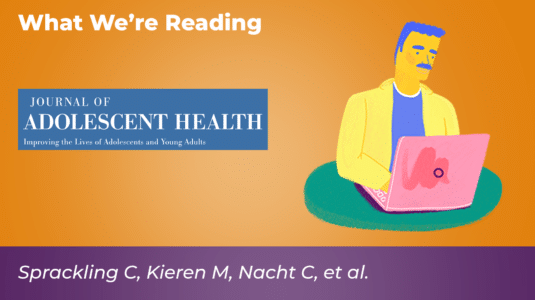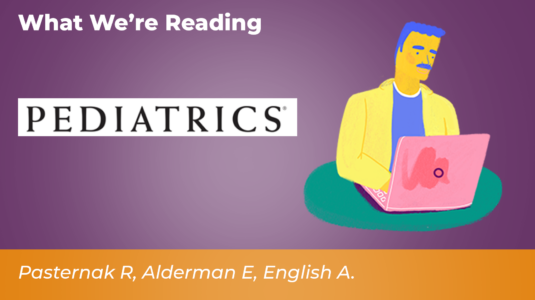This study aims to identify adolescent, parent, and clinician perspectives on the anticipated benefits and concerns of giving adolescents access to clinicians’ notes and strategies to support note-sharing in this population. These strategies may reinforce the potential benefits and mitigate the challenges of sharing notes with adolescent patients.
Adolescents
21st Century Cures Act ONC Rule: Implications for adolescent care and confidentiality protections
This article reviews the key aspects of confidentiality protections in adolescent health care, explains the ONC Rule, outlines clinical, HIT, and equity challenges associated with its implementation, encourages the development of policies protecting the confidentiality of adolescents’ EHI [ … ] and offers tools for analyzing key questions in individual cases and practical steps to address the confidentiality of EHI with patients and parents.
Lessons Learned from OpenNotes Learning Mode and Subsequent Implementation across a Pediatric Health System
The 21st Century Cures Act has accelerated adoption of OpenNotes, providing new opportunities for patient and family engagement in their care. However, these regulations present new challenges, particularly for pediatric health systems aiming to improve information sharing while minimizing risks associated with adolescent confidentiality and safety.
Attitudes, experiences, and safety behaviours of adolescents and young adults who read visit notes: Opportunities to engage patients early in their care
Today’s adolescents and young adults have grown up immersed in technology, but their interest in and benefit from reading their care notes online is not well understood. In our study, the majority of AYA read notes and rated them as extremely important for several engagement and safety behaviours. Although a similar proportion of AYA reported definite or possible errors in their notes as adults, fewer spoke up about them, citing knowledge and cultural barriers like fear of conflict. Taken together, these findings support initiatives that encourage AYA to read notes and share concerns. Efforts that include note-reading may help transition patients from paediatric to adult care with greater autonomy, activation and safety partnership.
The Value of OpenNotes for Pediatric Patients, Their Families and Impact on the Patient–Physician Relationship
Although limited by relatively low survey response rate, OpenNotes was well-received by parents of pediatric patients without untoward consequences. The main concerns pediatricians raise about OpenNotes proved to not be issues in the pediatric population. Our results demonstrate clear benefits to adoption of OpenNotes. This provides reassurance that the transition to sharing notes with pediatric patients can be successful and value additive.
Filling a gap in safety metrics: development of a patient-centred framework to identify and categorise patient-reported breakdowns related to the diagnostic process in ambulatory care
The PRDB framework, developed in partnership with patients/families, can help organisations identify and reliably categorise PRDBs, including some that are invisible to clinicians; guide interventions to engage patients and families as diagnostic partners; and inform whole organisational learning.
Co-development of OurDX—an online tool to facilitate patient and family engagement in the diagnostic process
Patients and their care partners are usually the first to notice new or changing symptoms and are the connecting “thread” between different healthcare encounters. In this article Sigall Bell, Fabienne Bourgeois, Stephen Liu, and Eric Thomas—along with patient partners Betsy Lowe and Liz Salmi—describe the co-development of an online tool called “OurDX” (Our Diagnosis) to engage patients and families in the diagnostic process
The 21st Century CURES Act in Pediatric Gastroenterology
The information blocking (IB) prohibition component of the 21st Century CURES Act (21CCA) comes into effect April 5, 2021, which gives patients and their families near instant access to almost all clinical notes, lab results, and health data. … A committee of pediatric gastroenterologists reviewed the 21CCA regulation and compared local practice policies. Pediatric practitioners need to understand how age will affect local information release policies and to know which note types are released, paying special consideration to trainee notes and confidential information. Extraneous detail should be removed from notes, emotional labeling be avoided, and objective statements be made when referring to the care of other providers. Awareness of the 21CCA provides pediatric gastroenterologists with the opportunity to adapt their medical documentation practices to accommodate the new law.
Speaking up about patient-perceived serious visit note errors: Patient and family experiences and recommendations.
About half of patients and families who perceived a serious mistake in their notes reported it. Identified barriers demonstrate modifiable issues such as establishing clear mechanisms for reporting and more challenging issues such as creating a supportive culture. Respondents offered new ideas for engaging patients and families in improving note accuracy.
Sharing Notes With Adolescents and Young Adults Admitted to an Inpatient Psychiatry Unit
Our data suggest that AYA patients with active behavioral health concerns understand and express general satisfaction with their medical documentation. Overall, reading medical documentation seemed to help a greater proportion of research participants as opposed to hindering or having no effect on inpatient counseling and therapy compliance. These are the first data to demonstrate medical note comprehension and satisfaction among AYA patients in vulnerable clinical settings.





